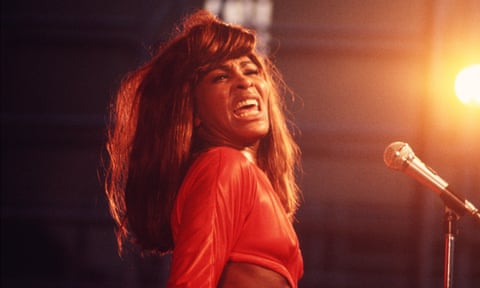Tina Turner was a giant of the decade that brought us sky-high Elnett hairdos and dazzling arena pop. Her swagger, sensuality, gravelly vocals and unstoppable energy were her trademarks and still evoke the kind of euphoria that remains synonymous with rock’n’roll. Yet in the mid-1980s – the outset of her second wind as a solo artist – she was also making history, executing these bold moves as a middle-aged African American female entertainer who had overcome severe personal and professional obstacles to reach the top.
Working with a cadre of white British songwriters, producers and rock stars – including Mark Knopfler, Jeff Beck and Heaven 17’s Martyn Ware and Ian Craig Marsh – she became the rare artist that crossed racial and genre lines, matching the fluidity of the 1980s superstar trifecta of Michael Jackson, Madonna and Prince, as well as that of her friend David Bowie, who was also in the middle of staging a massive return to the limelight. Bold Tina. Fierce Tina. Sui generis Tina. Don’t call it a comeback, I been here for years, Tina: the Tina of 1984 is the one most of us know best – a tempest blowing through pop – but her radical earlier relationship to rock music is often overshadowed by her heroic and inspiring biography.
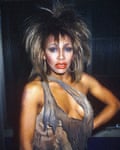
It is easy to fall for the romantic and all-too-real triumph of Turner’s story, made myth by Angela Bassett’s career-defining portrayal (with pre-Michelle Obama athletic arms) in the 1993 biopic What’s Love Got to Do With It, in which the resilient singer escapes her monstrous husband. Because of that, the story of her startling inventiveness as a musician slips by the wayside.
Her singularity as an artist is undeniable. Turner merged sound and movement at a critical turning point in rock history, navigating and reflecting back the technological innovations of a new pop-music era in the 60s and 70s. She catapulted herself to the forefront of a musical revolution that had long marginalised and overlooked the pioneering contributions of African American women and then remade herself again at an age when most pop musicians were hitting the oldies circuit. Turner’s musical character has always been a charged combination of mystery as well as light, melancholy mixed with a ferocious vitality that often flirted with danger. Perfect, then, for a big-budget musical.
The creative team behind Tina: The Musical includes the award-winning playwright Katori Hall and the Tony-nominated director Phyllida Lloyd. Their collaborative effort represents what may, in fact, be a new and welcome female-driven trend in popular culture, wherein stories of black women musicians are told by women. Director Dee Rees’s 2015 HBO biopic of blues singer Bessie Smith (Bessie, starring Queen Latifah) and Liz Garbus’s Academy Award-nominated documentary about Nina Simone (What Happened, Miss Simone?) both come to mind. Hall and Lloyd have the added advantage of receiving direct input from Turner herself, and the casting of Tony-nominated lead Adrienne Warren promises that this Tina will come to us with nuance and range.
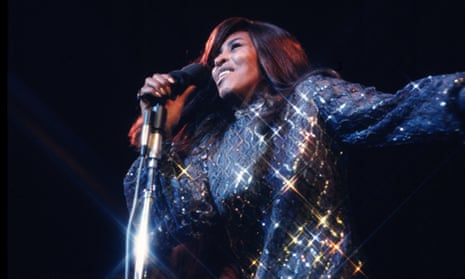
All that volatility, pleasure, drama and fearlessness has a history. Born Anna Mae Bullock on 26 November 1939 in Nutbush, Tennessee, she moved with her family to St Louis at the age of 11. In her teens, frequenting rhythm and blues clubs with her sister, she leaped from the groupie crowd to the stage with Ike and his Kings of Rhythm in a partnership that would become rock’n’roll infamy, rife with physical and emotional abuse and exploitation, and Ike’s frequent public displays of domination.
Dubbing her Tina and dressing her in long-haired wigs to evoke the aesthetics of Tarzan films, the would-be svengali sought to invent a stage persona for his future wife that consciously trafficked in old-school Hollywood’s primitivist trappings. He aimed to pimp her out in their act as animalistic, feral, wild and untamed. Caught between two kinds of patriarchy – in her own home and in the rock’n’roll marketplace where racialised sexuality undergirded the entire game – Turner’s resistance was, to some, hard to read in those heady years. She and the revue immersed themselves in late-60s rock bohemia, notoriously working as the opening act for the Rolling Stones and delivering the painful performance of Otis Redding’s I’ve Been Loving You Too Long, captured in the Maysles brothers’ 1970 Altamont concert film, Gimme Shelter.
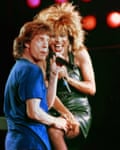
In that excruciating sequence, the camera tightly cropping Tina, she sings a song of suffering and addiction to love while caressing the microphone and uttering the sadomasochistic refrain, “Sock it to me!” as Ike hovers just outside the frame. From the sidelines, Mick Jagger watches what black feminist scholar Saidiya Hartman might call this “scene of subjection” unfolding for the masses. (Fifteen years later, the pair would perform together at Live Aid, with Jagger ripping off Turner’s trademark miniskirt in a move that summed up the racial and gender vulnerabilities that she had faced down throughout her life.)
In this context, the tightly choreographed go-go abandon and wicked high-stepping – Turner’s ultimate signature movements – could be read as their own fugitive escape strategies, forceful articulations of bodily agency in the midst of patriarchal rule. She and her fellow whirling sisters, the backup dancers the Ikettes, introduced a new form of rock’n’roll dance – the kind that would eventually yield those so-called “moves like Jagger” – breaking free of the rigidity of girl-group choreography.
But it was Turner’s voice that spelled liberation even more potently than her moves, and similarly crystallised the era’s insurgent shifts in rock’n’roll singing. Whereas Little Richard squealed his queer pleasures and James Brown screamed of funk rebellion – and the Brits who idolised them followed suit, Turner turned her abrasive timbre and audacious delivery into singing that reverberated with the newly emboldened spirit of an evolving pop phenomenon.
As Kurt Loder observes in the best selling memoir, I, Tina, co-written with Turner, her voice “combined the emotional force of the great blues singers with a sheer, wallpaper-peeling power that seemed made to order for the age of amplification”. It was a voice sturdy enough to match the high voltage of rock, this new offshoot that pumped up the volume of the electric guitar to maximum effect – and, as anthropologist Maureen Mahon has pointed out, depended on the “audible blackness” of black female backup singers such as the Sweet Inspirations and Gimme Shelter’s remarkable Merry Clayton.
Turner refused the backup position. Her dissonant singing style was a total rejection of that role and a seemingly wilful declaration that she might instead meld her voice with riveting, modern sonics. Her voice brought a new kind of noise to popular music singing – full of what critic Simon Reynolds describes as: “dips, swerves, lapses, use of space and architecture … antagonist ambiences and idioms, sampled from random points in pop history. The effect is psychedelia.” Jagger would say as much in I, Tina: “Tina’s voice was very powerful, and also very idiosyncratic – easy to pick out. River Deep – Mountain High was an excellent record because she had the voice to get out in front of Phil Spector’s so-called wall of sound.”
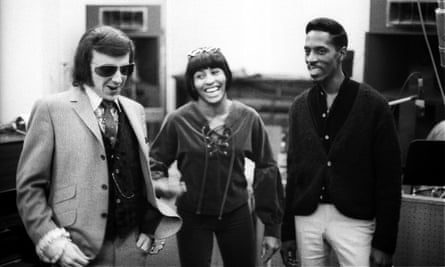
Like her tenacious dancing, Turner’s voice was her escape hatch, weapon and compass. We know she revelled in the freedom of working with Spector. “Ike would always have me screaming and shouting on his songs – selling them,” wrote Turner in her memoir. In contrast, Spector would ask her to “stick to the melody. He just wanted me to sing the song. It was my voice he liked, not the screaming. He told me I had an extremely unusual voice … and that was why he wanted to record me.” She credits him with encouraging her to use her voice to tell a story and not to merely generate spectacle to make Ike’s “money move”.
Turner’s rock’n’roll identity was ultimately her gateway out of her marriage to Ike and into her solo career. Although the rock circuit (and covering the likes of the Beatles and Creedence Clearwater Revival) would prove a lucrative way for the Ike and Tina Revue to expand their fanbase, it was Tina who, by the time she filed for divorce in 1976, had fully turned to rock as recourse, claiming her entitlement to perform music for which the 1920s blues queens (Bessie Smith and Ma Rainey) paved the way and which the 1940s and 50s path-breakers (Sister Rosetta Tharpe and Big Mama Thornton) had critically helped to invent.
She generated her own rendition of sonic blackness and femininity while gigging in the 70s, finding a new home for her voice as “the acid queen” in the 1975 adaptation of rock opera Tommy. And she turned to a whole new set of covers – Under My Thumb, Let’s Spend the Night Together, I Can See for Miles, Whole Lotta Love – turning those masculine (and often misogynist) narratives of power, desire, independence and sexual prowess into the sound of brave and unbridled, sexually and socially assertive womanhood.

The heir to Turner’s throne has long been Beyoncé, who paid homage to her foremother back in 2005 at the annual Kennedy Center Honors: “Every now and then, when I think of inspiration, I think of the two Tinas in my life – that’s my mother, Tina, and of course, the amazing Tina Turner …” Three years later, during the opening performance of the 2008 Grammys, the love-fest continued with Beyoncé celebrating the history of black women musicians and concluding her medley by introducing the “queen” (a line that Aretha Franklin would famously contest) to sway, “nice and easy”, right alongside her. The verse in Beyoncé and Jay-Z’s Drunk in Love, in which the rapper references a scene from the biopic in which Ike abuses Tina – “eat the cake, Anna Mae!” – was a less apt tribute.
Beyond Beyoncé, Turner’s legacies remain rich and varied in the world of pop, ranging from the brooding neo-soul of Meshell Ndegocello (who recently released a pensive, darkly lilting rendition of Private Dancer) to the underrated white funk vocalist Nikka Costa (whose 2005 cover of the Ike and Tina barnburner Funkier Than a Mosquito’s Tweeter revived the duo’s brand of nasty, in-your-face battle funk, all sweat and confrontation).
We see her brash and glamorous strut every time Rihanna takes to the stage, and even rapper Cardi B, with her stalwart posturing and vibe of unpredictability, owe Turner a bit of a debt. In our #MeToo age and with pop’s women unapologetically reclaiming their time, Tina: The Musical is poised to remind us of the sister who, legs and all, kicked open the door for this moment.

